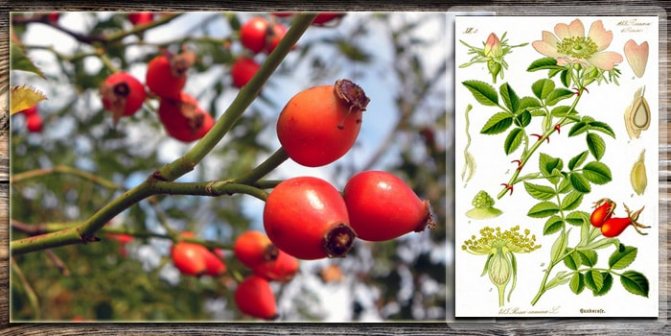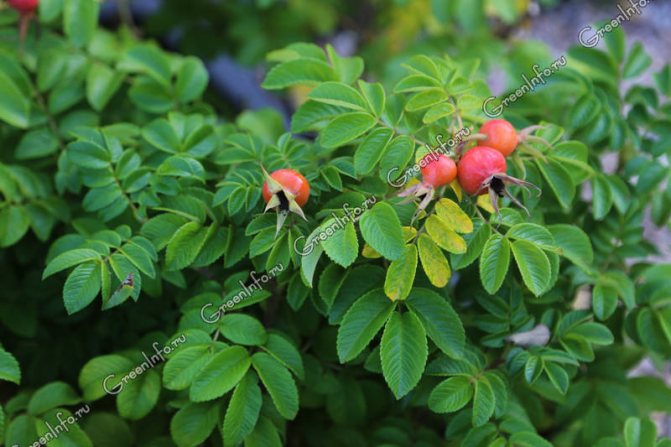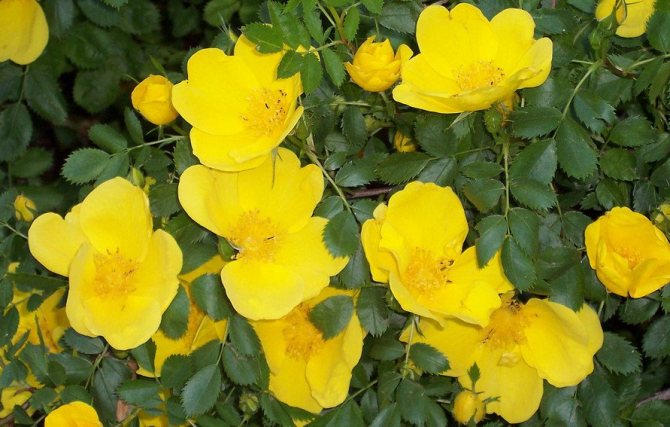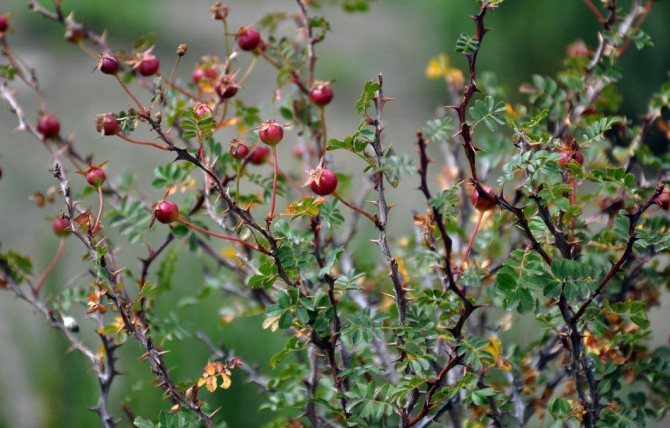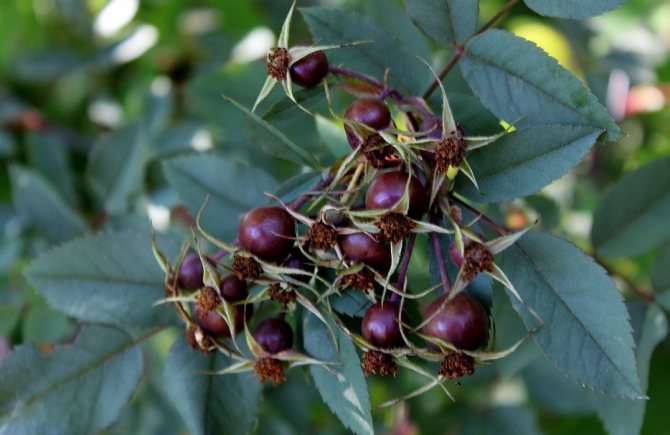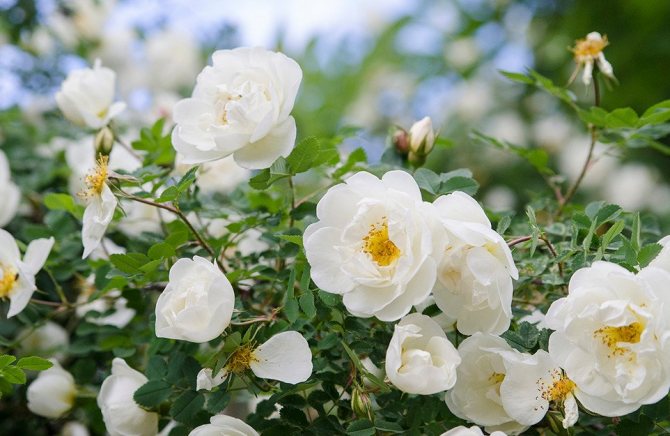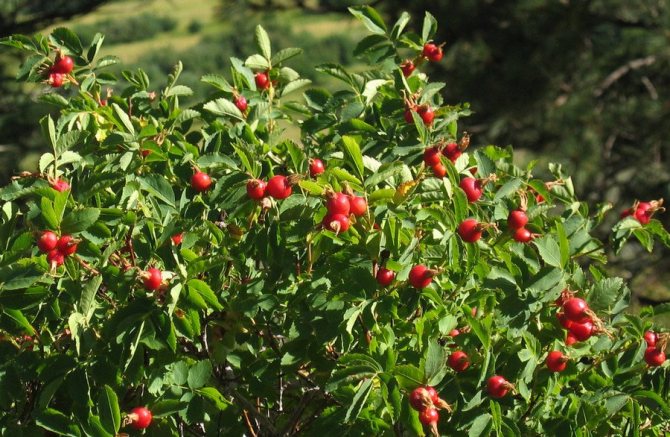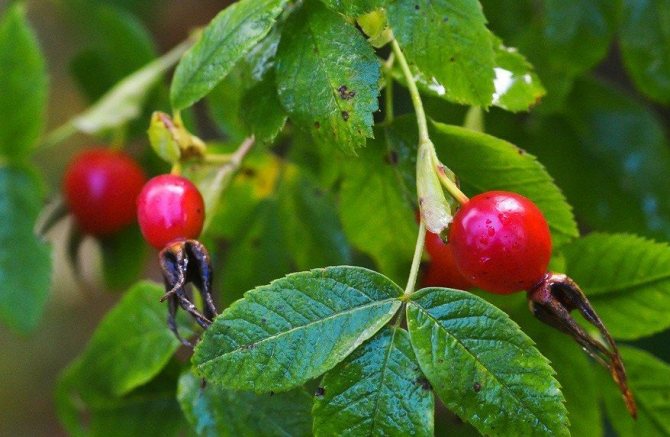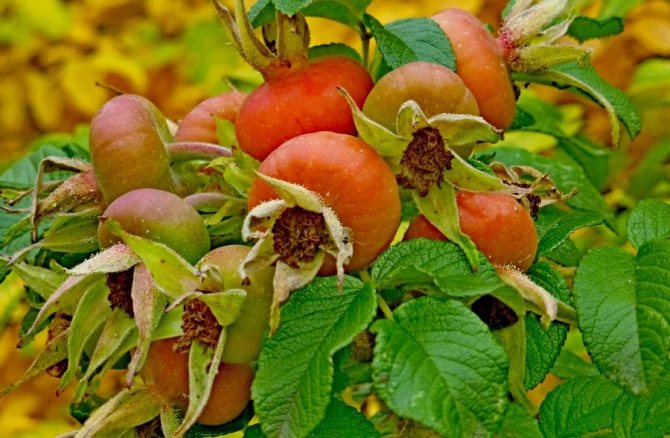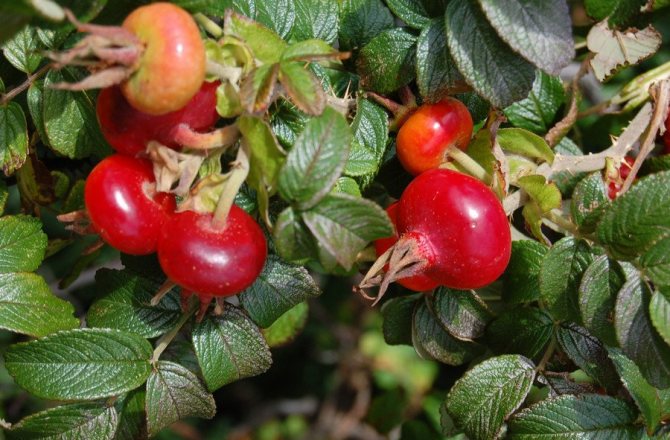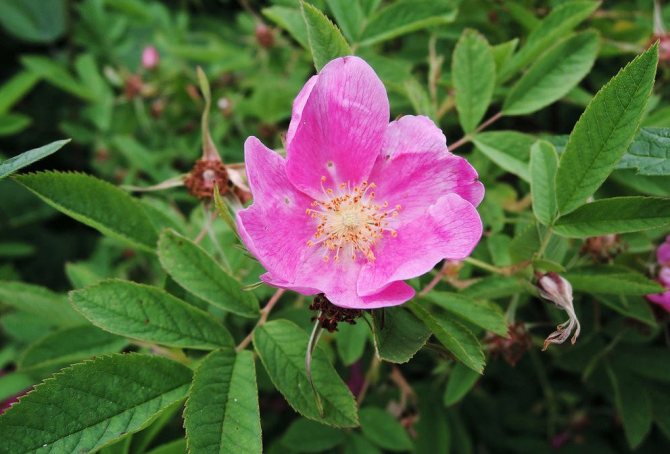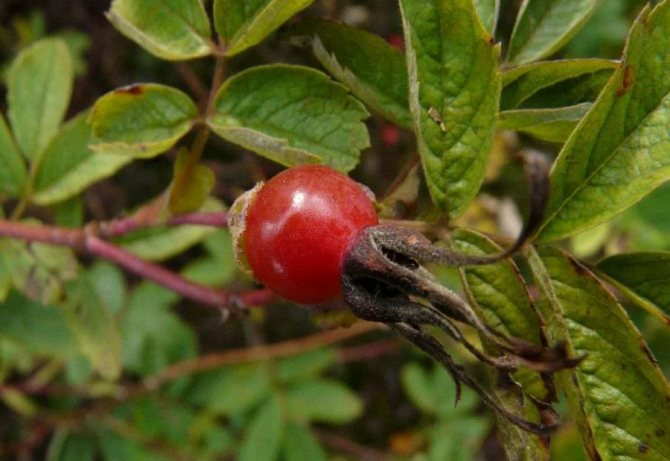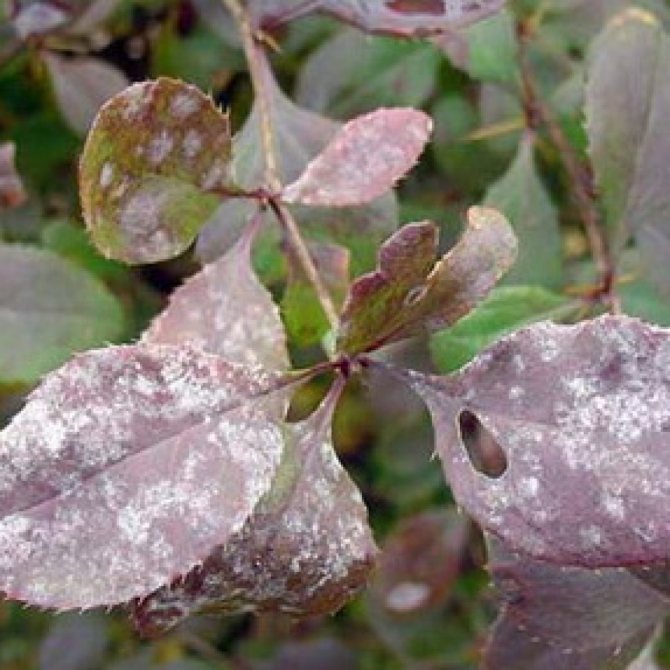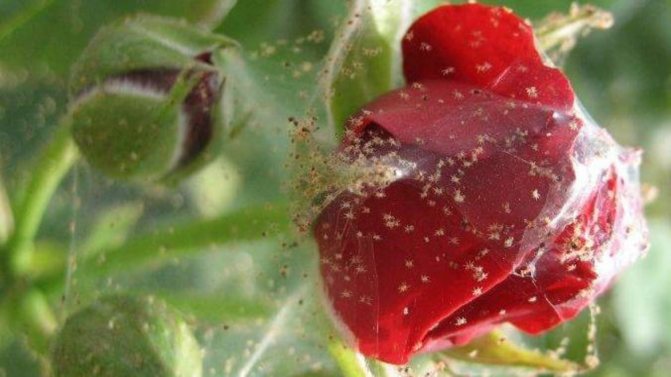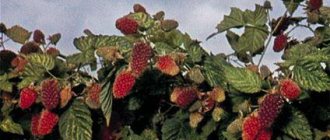"White rose, wild rose - more beautiful than garden roses" - this line from the play "Juno and Avos" was familiar without exaggeration to all residents of the Soviet Union. The romance was so popular that this not very noticeable shrub became a symbol of beautiful love with a tragic outcome.
Indeed, it may not be more beautiful than garden roses, but it is in no way inferior to them either in smell or in the beauty of delicate flowers. Only a little wild, but this also has a peculiar charm. Rosehip is also familiar from the fairy tale "Sleeping Beauty", in which the royal palace with all its sleeping inhabitants was overgrown with wild thorns and rose hips during the night, the thorny branches of which, intertwining, turned into impassable thickets.
Rosehip, the most vitamin varieties
At our variety plot cultivated, for example, "Russian-1", "Vorontsovsky-3", "Vorontsovsky-2", "Vorontsovsky-1". The bush of these varieties of rose hips gives 1.6-1.8 kilograms of fruit each. Each of them weighs 1.1-1.5 grams. Much larger are the fruits of the "vitamin VNIVI" variety, each - 2.5 grams, and the yield from a bush at our cultivar plot reaches 2.5 kilograms.
Amateur gardeners will be interested in the "studless" rosehip. It is called so because it has almost no thorns. This variety is inferior to others in terms of yield and vitamin content, but it is very convenient for harvesting fruits.
Most of all vitamin C in the "Vorontsovsky-1" rosehip - 3.900 milligram-percent. In "vitamin VNIVI" its 3.720 milligrams.
Name and classification
Rosehips have a great variety of names - they did not even try to count them all to a single one. More than three thousand names are mentioned in scientific literature. It grows mainly in cool climates and is common both in Eurasia and in the Americas. Only in the tropics it is not. Now the white rose is a very popular garden plant. What is he like? He has a scientific name: multiflorous rosehip. According to the scientific classification, it belongs to the plant kingdom, the angiosperms department, the dicotyledonous class, the Rosaceae order, the pink family. This plant species and subfamily (Rosanovye), genus (rosehip) and species (rosehip multiflora, or Rosa multiflora) has this plant species. He comes from Taiwan. The shrub is the progenitor of all types of roses on earth, its age is more than respectable - some sources indicate a figure of 40 million years. But now the double rose, red, white, yellow and cream are hybrids from the rosehip itself with simple, but very fragrant flowers.
How to best grow rose hips
When landing make sure that the root collar of the seedling is at ground level. Then the plants are watered and spud.
Spring next year the overwintered rosehip is uncooked, the main branches are cut off above the fourth - sixth bud. In the future, when caring for a bush, root shoots are pruned, weak shoots, broken and diseased branches are removed, and six - seven-year-olds are rejuvenated.
Correctly formed bush should have up to ten basal branches of different ages. Bite stripes are best kept loose and free from weeds.
Rosehip must be protected from pests and diseases. The vegetative and generative organs of the shrub can be affected by powdery mildew, especially in wet years. Against fungal diseases, it is useful to treat bushes and the soil under them with copper sulfate (10 grams per liter of water) or nitrafen (20-25 grams per liter) in the early spring.
Sapling planting rules
Saplings of white rose hips, like any other, take root best when planted in autumn. It is recommended to plant them in October or November. How does this happen?
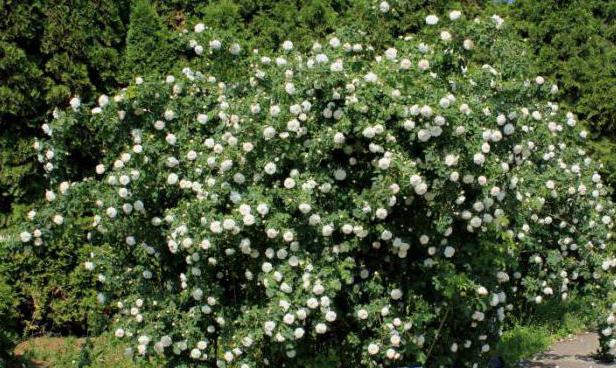
First, you need to dig a hole 20-22 centimeters deep. It is advisable to treat the soil - if it is acidic, it is necessary to add lime fertilizer. Add rotted manure and compost to the same hole. There are certain planting rules. So, before planting, the seedling is cut off so that the thick branch is no longer than 8-10 cm, root cuts up to 10-15 cm are also made. Before planting the seedling in the hole, dip the rhizome in a clay chatter so that the roots do not dry out.
Choosing rosehip varieties with large edible fruits
Adding an article to a new collection
Rosehip is a great garden plant. During flowering, its bright buds decorate the site and fill the air with the scent of roses, and the ripe fruits are not only edible, but also very useful.
Most varieties of fruit rose hips come from 4 types of roses: cinnamon, wrinkled, dahurian and gray. According to the shape of the fruit, rose hips are usually divided into 2 groups:
- with large fruits (from 4 g or more) with dense skin,
- with small fruits (less than 4 g) with thin skin.
The fruits of the first group are similar to small apples. It includes varieties such as Jubilee, Oval, Globus, Apple. Berries of these varieties can be eaten fresh, and they also make good jam. The varieties of the first group are distinguished by repeated flowering, which means that the fruits from them can be harvested several times from August to October.
The second group includes small-fruited rosehip varieties. But that doesn't mean they are less useful. It's just that their yield is less, so if necessary, more bushes will have to be planted. Among the varieties of this group, one can distinguish Vitaminny VNIVI, Vorontsovsky 1, Titan, Rubin. Their fruits are great for drying.
Giving love
The described wild roses include the white rose hip Rosa Alba. This is the same "culprit of passion", sung in the legendary Lenkom performance, - a bush with simple white flowers.
It should be noted that it was about him, about the white rosehip with its magical ability to arouse love in the hearts of people, was written in various medieval books with conspiracies.
There was such a mysterious person as Milokh Zaruzhny, who in his "writings" wrote that if two people scratch themselves on the same branch of a white rosehip, then the flared up mutual passionate feeling will survive the centuries, because only this plant is able to bind hearts of even the most diverse of people. Love potions are prepared from it, which can cause tenderness and passion.
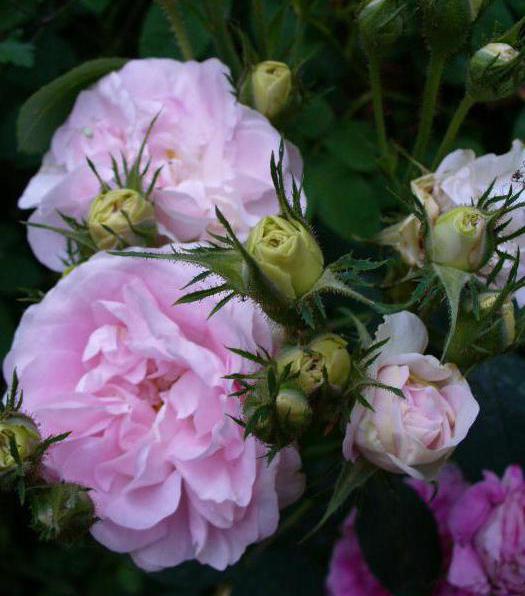

And if you collect the branches of the white rose hips on the full moon in November, dry them and wear them as a talisman, then neither a vampire nor a sorcerer will be able to suck blood or energy out of a person. And the amulet made from a mixture of flowers or twigs of white rose hips, hawthorn berries, branches or pine cones becomes completely omnipotent. Rosehip with white flowers heals the heart, cleanses and restores blood, gives people love, peace and happiness.
Rosehip varieties
Now is the period of mass sale of seedlings. Even the most outlandish plants can be found on the market. It is worth taking a little time to find varietal rosehip seedlings. They are much healthier and more productive than wild varieties.
Large-fruited VNIVI Vitamin Vorontsovsky 1
Of the first created rosehip varieties, only four were zoned: Large-fruited VNIVI, Vitaminny VNIVI, Vorontsovsky and Rossiyskiy.
The most impressive is Large-fruited VNIVI
... Its fruits reach a weight of 12 g, and the plant is strewn with large fruits from head to toe. A serious drawback of this variety is the huge number of thorns.
Vitamin
- it has a higher ´ vitamin content than the competing varieties, and its thorns are located only in the lower part of the bush. BUT
Russian
- has medium fruits and is well adapted to our unpredictable climate.
Although these varieties are considered yesterday. Newer ones are now in use: Victory, Finger, Apple, Titan, Malk
and etc.
There are also foreign varieties. They are very large-fruited, productive and unpretentious, but in terms of the content of vitamins they are significantly inferior to our varieties. And therefore it is worth taking them mainly for the sake of a decorative effect.
New varieties are usually divided according to the thickness of the fruit wall. Thin-walled ones are best for drying. In this regard, the following varieties have proven themselves well: Vitamin VNIVI, Vorontsovsky 1, Russian 1, Titan, Apple.
The universal grades have an average wall thickness. Of these, the most popular are Ruby, Crimson, Victory and Spire.
The spire is also notable for the fact that it has thorns only in the lower part of the bush. Well, the most thick-walled fruits are in varieties
Anniversary
and
Globusoni
... They are the best for processing into vitamin drinks and syrups.
It is noteworthy that all varieties are highly resistant to fungal diseases.
yard.
Growing features
Caring for a wrinkled rose is really easy. These shrubs are not particularly sensitive to temperature extremes and droughts. But in order to get a beautiful color, it is better to create optimal conditions for the plant.


It is better to plant rugoza seedlings in early spring.
The shoots of the rugosa rose must be cut off, leaving no more than one third of the total growth of the seedling. The wrinkled rose looks great both in single planting and in small groups. This plant is ideal for creating an ornamental hedge. In spring and summer, rugoza will delight with luscious greenery and very beautiful, fragrant flowers. And in the fall - purple and crimson foliage, contrasting with orange fruits.
The wrinkled rose fence performs not only decorative functions. It will reliably protect the garden from intruders thanks to its rather long and sharp thorns.
After planting, fertilization is not necessary for the next two years. In the third year, with the onset of spring, urea must be added to the soil at the rate of no more than 20 g per square meter of soil. When the bush begins to bear fruit, fertilize it like this:
- once every 3-4 years, up to 15 kg of organic fertilizers (humus or peat) are applied per square meter of soil;
- With about the same frequency, mineral fertilizers are applied in the same amount as when planting - 50 g of superphosphate and 20 g of potassium salt per square meter.
Read also: Kalanchoe pinnate: the use of useful properties for medicinal purposes
In adult plants, the roots can penetrate to a depth of 2.5 meters and grow very much in breadth. On the one hand, this is good, the plant will easily endure forced drought. But on the other hand, such a bush will bear fruit worse. To prevent this, it is recommended to dig sheet metal or other similar material around the bush.
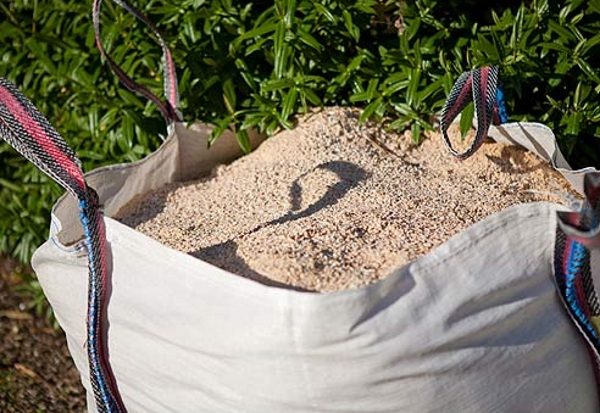

Rugosa needs to be fed starting from the third year of life.
"Large-fruited VNIVI"
This variety has a sprawling, vigorous bush. The height of the bush reaches 2 m. Annual branches of the plant have a green tint, and perennial ones are gray-brownish. The branches of the plant are dotted with numerous thorns along their entire length.
The blooming of the large-fruited VNIVI rosehip begins in June and continues until the first frost. During this period, large flowers of a pleasant pink color bloom on the branches.Around August-September, large fruits of a round, slightly flattened shape ripen.
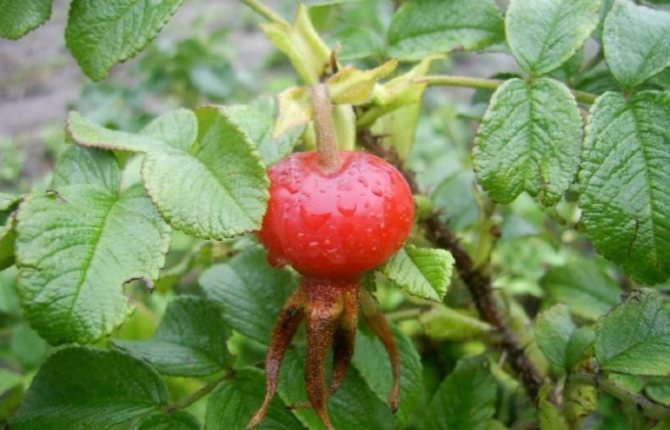

The fruits are covered with a shiny and smooth orange-red skin. As a rule, 3-4 kg of berries can be harvested from one bush per year. Of advantages this variety can be distinguished:
- good resistance to low winter temperatures;
- high productivity.
disadvantages consist in a large number of sharp thorns and a low content of vitamin C in comparison with other varieties.
Description of the wrinkled rose and its fruits
Wrinkled rose (wrinkled rose, rugosa rose) - a wild species from the Far East, East Asia, it is a tall (up to 2 meters), spreading bush.
A description of a wrinkled rose should start with its leaves: they are dark green wrinkled, glabrous above, and pubescent below, very unusual and decorative. The shoots are equipped with numerous thorns of various lengths and thicknesses, which reliably protect the bush.
As you can see in the photo, the wrinkled rose has large white or purple-red flowers, single or in groups up to 6 cm in diameter, appearing at the ends of the shoots from June and blooming until autumn:
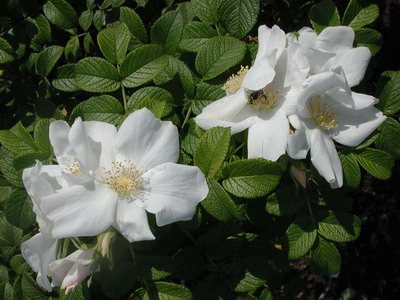

They are bisexual and very fragrant, resistant to all adverse weather phenomena - whether it is raining or windy, heat or temporary cold snap. Flowers are laid, both on last year's and young shoots of the current year, and therefore give such abundant flowering.
The same richness and fruits of the wrinkled rose: they are large (up to 2.5 cm in diameter), bright scarlet, fleshy, edible, similar to small paradise apples.
Often on the bush there are both flowers and fruits at the same time due to shoots of different ages. The fruits of the wrinkled rose hips hang until late autumn, presenting a valuable find for both birds and people.
Wrinkled rose is a long-lived stem shrub.
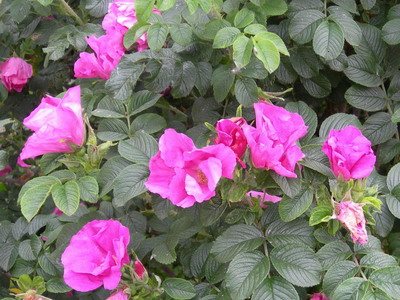

In the first year, an unbranched shoot 7-12 cm long with up to 14 leaves appears from the seed. In the second year, the apical bud does not develop, and several lateral branches grow from the upper lateral buds. In addition, 2-3 strong shoots, reaching 20-25 cm, called tillering or replacement shoots, develop from the base of the stem.
In the third year, tillering shoots branch, and below their base, from the root collar, another 4-5 stronger shoots, 40-45 cm high, develop. They can bloom in the year of their appearance. In the same year, the development of the rhizome begins from the root collar, which forms root suckers by autumn.
In the fourth year, the root system develops, initially weak and insignificant. Tillering shoots do not form their roots.
Look at the photo: the wrinkled rose hips are in a state of constant flowering from June to October:
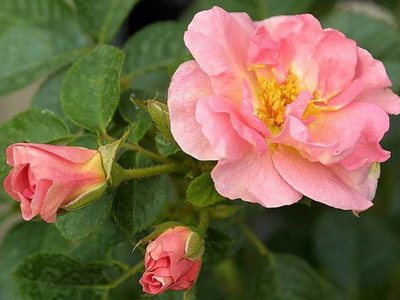

This happens due to the emergence of new shoots of replacement and the withering away of old ones completely only by the sixth year of life. That is why this shrub is also called a remontant rose.
"Scarlet"
The variety "Crimson" has a medium spreading and medium-sized bush, reaching two meters in height. The thorns of the plant are short and located closer to the base of the branches.
The berries of this plant have a pronounced pear-shaped shape and have a long green stalk. The fruits themselves are bright red, have a rich sweet and sour taste.
"Crimson" is characterized by an average ripening period. Its main advantages - high winter hardiness and increased resistance to fungal diseases such as powdery mildew. But at the same time, the plant can be affected by black spot.
Crown formation
Pruning a bush is a mandatory and necessary moment in caring for a wrinkled rose. They begin to cut the shrub in the third year after planting. All weak shoots, branches lying on the ground, as well as root suckers that are not far from the bush are removed.Only five well-developed, strong shoots are left, the branches are cut to a height of 15-18 cm.
Pinching will help stimulate the growth of side branches and fruiting. It is carried out when the shoots reach 70 cm in height. Further, you need to annually cut off those branches that bear little fruit, dry out or get sick. In order for the bush to bloom luxuriantly and bear fruit well, it is important to control the number of branches in it. There should be no more than 20 of them in a plant of 6-7 years old.
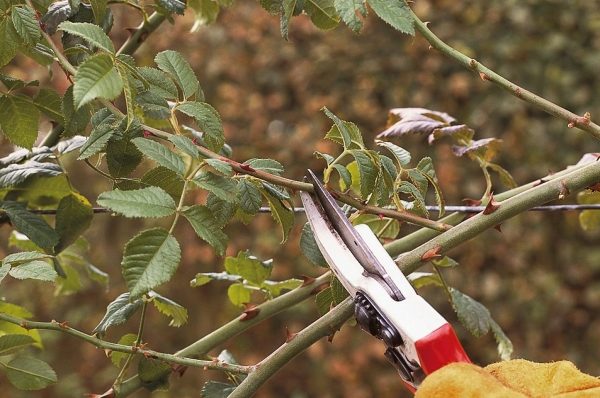

Timely pruning stimulates the growth of young shoots and abundant flowering.
"The globe"
Globus bush is medium-sized, branches are of medium length, thick and curved. The tops of the branches hang down slightly. The shoots of the plant are light green in color and are covered with thorns almost along their entire length, which become smaller in the upper part.
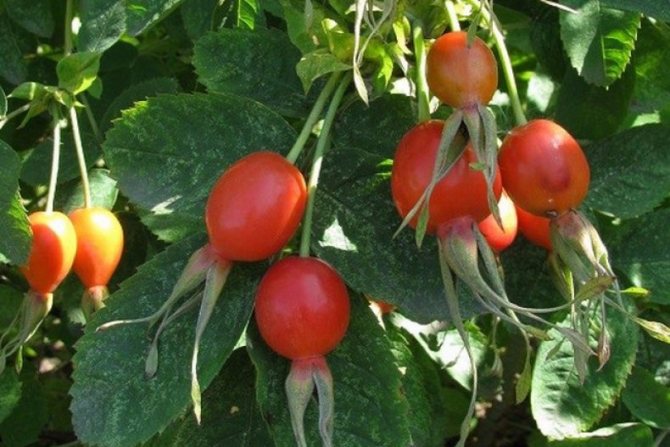

A large rosehip leaf has a light green color, the leaf blade is matte, naked and leathery. The rim of the leaf is dotted with blunt teeth. Average weight of fruits is 3.5 g. Fruits are round, light red in color with long stalks.
When choosing a place for planting, remember that the plant is very light-loving. Grows well in fertile, drained, sandy loam or loamy soil. The close occurrence of groundwater has a negative effect on the plant. the main thing advantage plants - good frost resistance.
The height of a bush of this variety can reach three meters. The branches of the plant are of medium thickness, straight, often green in color. Rosehip practically thornless, since thorns are few in number and they are all located at the bottom of the branches. Flowers of the "Luch" variety have a pale pink hue.
The berries are red in color, rather large, weighing from 3.4 to 5 g. The berries are elongated and have an oval or conical shape, they have a sweet and sour taste.
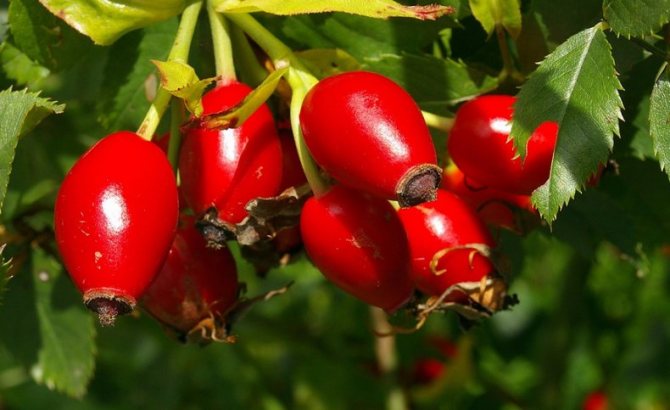

Among advantages can be distinguished:
- high winter hardiness;
- high productivity;
- resistance to powdery mildew and various pests.
This variety is characterized by a medium ripening period, making it excellent for industrial cultivation and subsequent processing. The height of the bush is 1.5 m. This type of rose hips has medium-length shoots, they are usually curved, and their surface is dull.
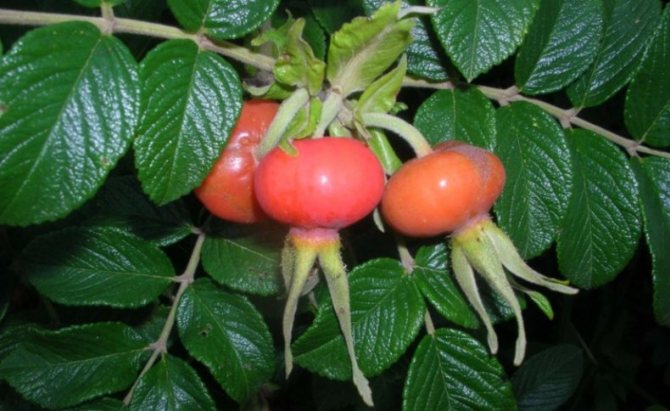

Medium-sized thorns run perpendicularly along the entire length of the branch. The leaf plates are dull, glabrous, leathery, wrinkled, concave inward. Sharp denticles are located at the edges of the leaves.
During the flowering period, the bush is covered with medium-sized white flowers. Fruit ripening begins in mid-August. The weight of the fruits reaches 9 g, the fruits are slightly flattened, have a thick cream-colored skin. The advantages of this variety are good frost resistance and resistance to various pests and diseases.
Shrub appearance
White rosehip is a shrub plant. Straight-grown, it looks very picturesque and graceful - arched branches, decorated with white flowers, are widely spread and hung. Deciduous and fast-growing, it is 2-3 meters in height, less often 5, in width reaches 3 meters. The bark of this shrub is brownish and reddish-green, shoots are either with a small number of thorns or without them at all. The leaves of the white rosehip are alternating, in addition, they are pinnate - the branch ends with a leaf that does not have a pair. Their length varies from 5 to 10 centimeters, width - from 2 to 3 cm. On a branch there can be from 7 to 9 pieces. The top of the leaf is usually green and shiny, while the bottom is matte. The leaves are slightly pubescent and do not fall off for a long time.
"Ruby"
The bush of this plant is quite vigorous, its height can reach 2.5 m. The shoots are dotted with thorns along their entire length, but most of them are at the base. "Ruby" has large green leaves.
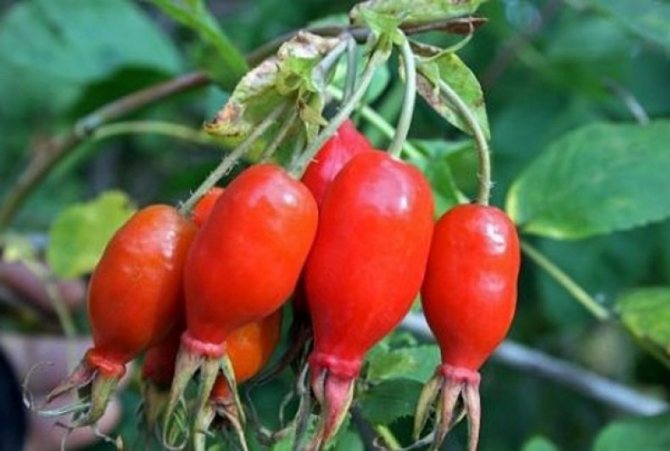

The berries are also large, on a branch they are located in small groups. The shape of the berries is round or elongated-oval, the color of the fruit is dark red.The fruits have a pleasant, sweet-sour, refreshing taste. Fruit ripening occurs in early August. One kilogram of berries can be harvested from one bush of a plant.
Hardy unpretentious plant
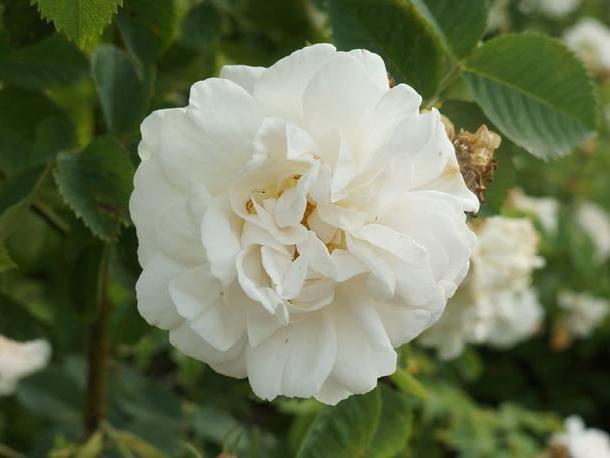

In Europe, there are up to 40 species of this plant, the most common is the cinnamon rosehip, or May. And what habitat does the white rose hip have? These are mainly China and Japan, Korea and Taiwan. But this is in the wild. Now this shrub is cultivated in Europe. It is so widespread primarily because it is undemanding to the environment. Grows on all drained soils - on acidic and neutral, dry and damp soils. Although this shrub is photophilous, it is quite shade-tolerant, frost and wind resistant, and also tolerates heat and drought well. Fruits that remain on the branches until winter are able to withstand temperatures up to 8 degrees with a minus sign.
"Titanium"
The Titan Rosehip can be described as a very showy plant with large fruits and powerful shoots. The height of the bush of this plant reaches two meters. In mid-August, flowering begins, during which the bush becomes a real decoration of the site.
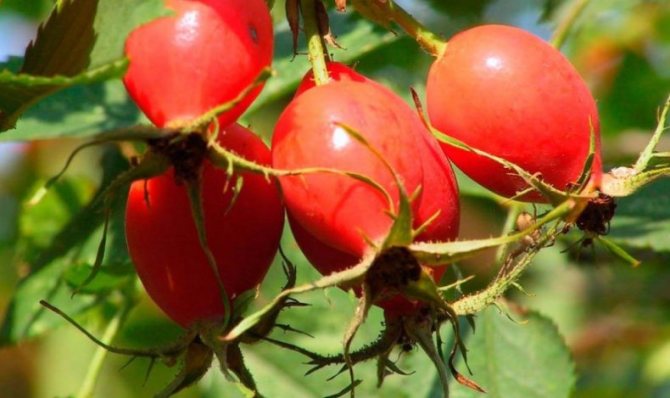

Variety "Titan" blooms very beautifully, dissolving flowers of a delicate light pink hue. Berries grow in clusters of 3-5 pieces each. This variety steady to low temperatures and diseases, and its berries are excellent for storage in a dried form.
Pruning and propagation of wrinkled roses
Knowledge of the biology of shoot formation helps to properly rejuvenate the bush. Pruning a wrinkled rose involves removing 5-6-year-old shoots and removing faded tops. Such care ensures abundant and constant flowering.
Rose rugosa - the plant is frost-resistant, withstands both severe and winter with intermittent thaws without damage.
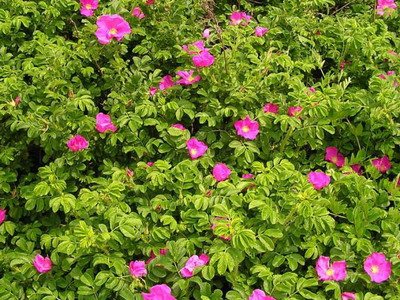

In summer it is heat-resistant and does not require systematic watering. It is also not demanding on the soil, but prefers well-drained moderately moist, non-flooded loams.
When caring for a wrinkled rose for constant flowering, regular feeding is required at least twice a month, alternating full mineral fertilizers with organic ones.
Rosehip rugose, along with dog-rose, is most widespread as rootstocks for cultivated roses.
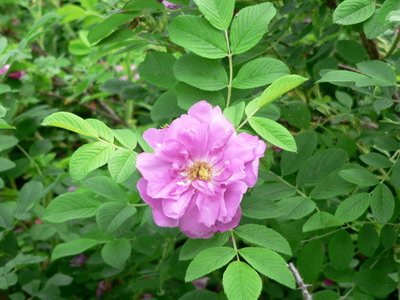

The disadvantage of it as a rootstock is the abundance of root growth, but this must be neglected due to the powerful root system, good, comfortable root collar and lagging of the bark during sap flow. The rootstock is most promising for high varieties from the remontant group.
Reproduction of the wrinkled rose is carried out by seeds, root suckers and stem cuttings. Stem cuttings are cut in the fall and stored in a box with damp sand at a temperature of +4 ... + 5 °.
Mainly rootstocks are propagated by seeds. Seeds ripen from late July to October. Collect them as soon as the fruits begin to stain, not allowing the shell to harden strongly. Seeds are sown both in autumn, immediately after collection, and in spring, after preliminary stratification.
"Anniversary"
This variety is characterized by medium ripening... This species has a powerful, strong, but at the same time relatively small bush up to 1.5 m high. Experienced gardeners can immediately identify this variety, since such a rosehip blooms with large pink flowers that look great on the bush.
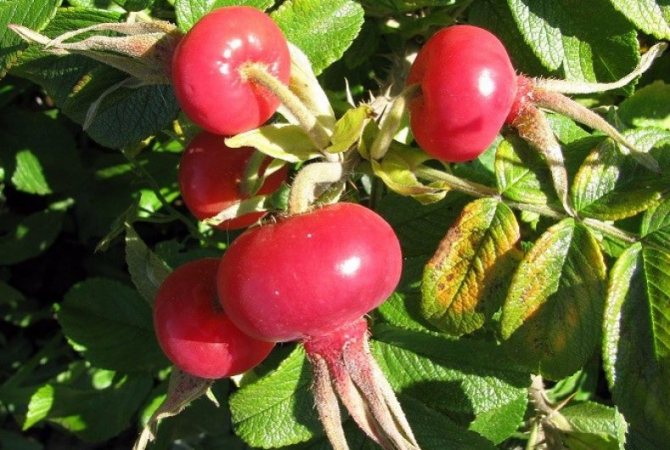

Fruits of the "Yubileiny" variety are large enough, round in shape, similar to small bulbs. The fruits have an orange-red hue and a pronounced sweet and sour taste. The berries of the plant can be dried or made into a jam.
Wrinkled rose - the unique charm of a wild beauty
Wrinkled rose is a very unusual and beautiful plant that attracts the eye with its amazing flowers and leaves. Other names for wrinkled roses are wrinkled rose hips, rugosa rose.Latin names: Rosa rugosa, Hybrid Rugosa (abbreviated HRg). In its natural environment, wrinkled rose is found in the Far East, North China, Korea. But Japan is considered the homeland. There are two main varieties of rugosa rose - the first blooms in white, and the second is easily recognizable by its dark pink, crimson or red flowers.
Read also: Decorative honeysuckle: planting and care
Russian breeders (in particular Michurin and Regel) noticed this flower in the late 19th and early 20th century. Since then, numerous hybridization experiments have begun. The most successful specimens to this day are included in the best collections in the world and take prizes at international exhibitions. It is difficult to find exclusive varieties in nurseries, only a few are presented for sale.
"Apple"
A bush of the Yablochny variety often does not grow higher than 1.2 m, but in terms of yield, it practically does not lag behind tall varieties. During the flowering period, the Yablochny rose hips bloom dark red flowers.
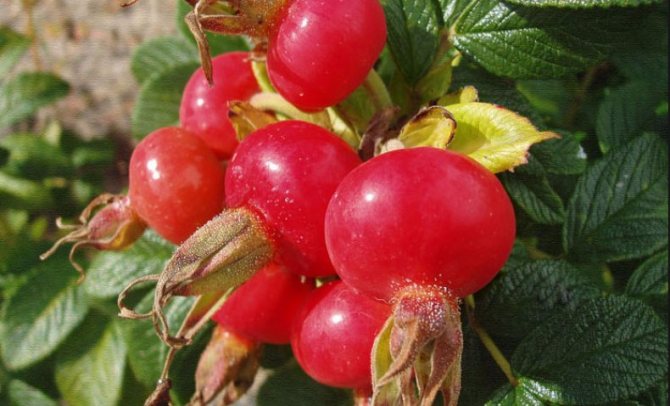

The fruits of this variety, like the flowers, have a dark red color, they are large enough and often grow in small groups of 5-7 pieces. Fruits are flat-round in shape, with a rich sweet and sour taste.
Large-fruited rosehip varieties can perfectly decorate almost any plot of land and delight the eye with their bright flowering. At the same time, in addition to aesthetic pleasure, rose hips have a positive effect on the human body.
Necessary care
Then the question arises: "How are the seedlings grown and how are they looked after?" Despite the fact that the rose hip is called a wild rose, it still requires constant care. And although it is not very difficult - to remove weeds in time, loosen the soil, water, cut off dried branches - this business should not be left to chance. From the age of two, it is necessary to cut off dried and non-fruiting branches. From the age of eight, rejuvenating pruning is performed, and the branches are pruned at the very ground - this ensures abundant emergence of basal shoots. If the plant was not planted on a nutrient medium, it is necessary to carry out systematic feeding.
No plant is immune to disease or pests. Especially from pink flies. It should be noted that now there are a lot of all kinds of drugs to combat these misfortunes.
Modern varieties of rose hips
Probably, it was the successful combination of the beauty and benefits of the rose hips that made it an indispensable part of the Russian estate. It will not be superfluous in a modern suburban area.
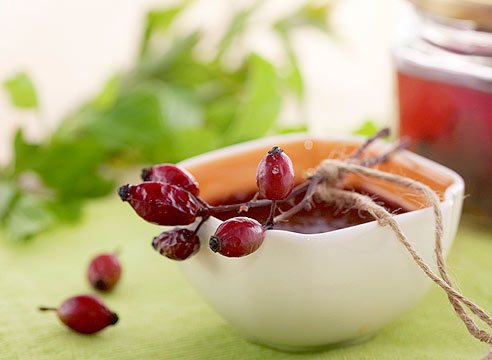

Most of the fruit varieties of rose hips are bred on the basis of cinnamon, wrinkled, dahurian and gray roses. According to the size of their fruits, they can be conditionally divided into two groups: varieties with large fruits (4 g or more), having a thick, fleshy pulp, and with thin-walled, small fruits.
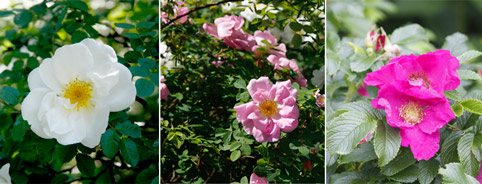

The first group, the fruits of which look like small apples, includes the varieties ‘Yubileiny’, ‘Gift of Summer’, ‘Hedgehog’, ‘Oval’, ‘Tambovchanka’, ‘Geisha’, ‘Apple’. The fruits of the ‘Yubileiny’ weigh up to 10 g, ‘Hedgehog’ - up to 12 g, and the yield is 4–5 kg per bush. They make a wonderful jam and are even eaten fresh. Since the large-fruited varieties contain a lot of seeds, they can be used to obtain oil. Varieties of this group bloom again, which means that they have an extended period of fruit ripening. For example, a 'Geisha' crop can be harvested from August to October. Plants are planted at a distance of 1–1.5 m from each other.
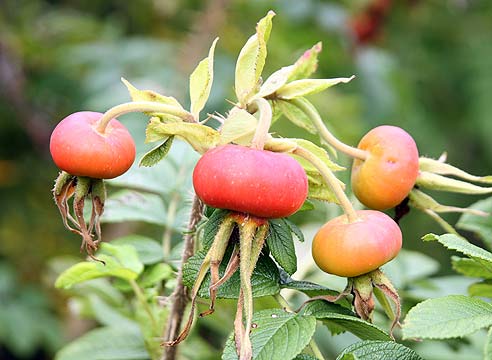

The fruits of the second, small-fruited group are ideal for drying. These varieties are ‘Besshipny’, ‘Vitamin VNIVI’, ‘Vorontsovsky’, ‘Captain’, ‘Rubin’, ‘Titan’. Their yield is less (2–4 kg per bush), there are few seeds, and the bushes are 3-4 m high. They should be planted at a distance of 2.5–3 m from each other.
In principle, in order to protect oneself from various diseases during the year, two or three bushes of large-fruited varieties and a couple of small-fruited bushes are enough on the site for drying. However, to get to the coveted vitamins, you need to overcome the plant's natural obstacle - rather sharp thorns. The trouble in the form of punctured hands can be avoided by choosing varieties with single thorns on the shoots: ‘Besshipny’, ‘Vorontsovsky’, ‘Victory’ and ‘Rosy’.
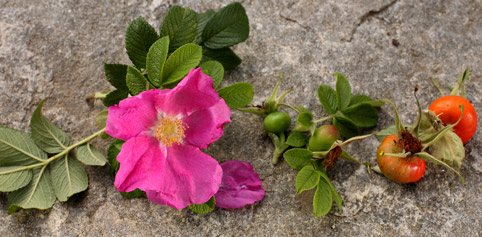

But thorny plants should not be neglected: ‘Gift of Summer’, ‘Yubileiny’, ‘Tambovchanka’, ‘Hedgehog’, ‘Geisha’ will be greeted fully armed with uninvited guests, standing up in a hedge to protect the site.
Some details
Although they say that it is a thing of the past, and various nutritional gels come to replace it, the talker is still quite in demand. Then we straighten the roots and set the seedling so that the rhizome drops 5-8 cm below the soil surface. Next, you need to cover the roots with prepared earth, pour water and sprinkle the planted seedling with sawdust or peat.
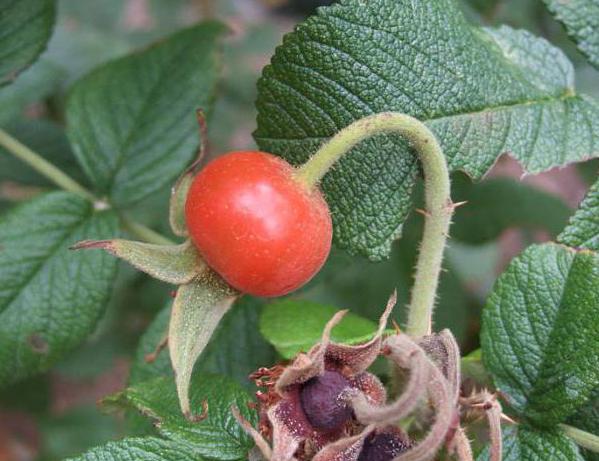

In specialized stores there is a very large selection of seedlings of all popular types of rose hips. It is necessary to specify the distance between the planted plants. If a hedge is being made, 50 centimeters between the holes will be enough. If the bush is planted in order to obtain bountiful harvests of fruits, there should be much more space around the bush. It should be added that vitamin varieties are planted only vegetatively (a method of asexual reproduction, when a new one is obtained from the multicellular part of the parent's body) - by grafting, cuttings and layering.
Wrinkled rose: varieties with photos and descriptions, care, reproduction
The wrinkled rose belongs to the wild rose family and is an unpretentious flowering bush, quite easy to care for and plant. All this makes the wrinkled rose popular with many gardeners in Russia and abroad. It is an interesting and peculiar plant that attracts the eye with its flowers. It is also sometimes called wrinkled rosehip or rugosa rose.
In the wild, it can be found in countries such as China, Korea, Japan or in Russia in the Far East.
In the modern world, attention is focused on two main varieties of wrinkled roses: blooming with white flowers, and with flowers of a dark pink, crimson or red hue.
Experiments on hybridization of this species have been carried out in Russia since the beginning of the 20th century, and the most successful finds resonate at exhibitions, but it is very difficult to find them on sale.
Rosehip rugose possesses high frost resistance, tolerates drought, soil and air pollution well. He also quite calmly tolerates waterlogged soil.
When these properties are combined with a long flowering period, the park rose becomes popular for landscape design, easily fitting into its style and harmoniously combining with other plants.
With the help of this rose, you can create hedges, design various zones on the site and highways in the city.
It is a strong, spreading shrub with an erect stem covered with reddish thorns, needle-shaped small in size and crescent-shaped in large size, growing up to 2.5 meters in height.
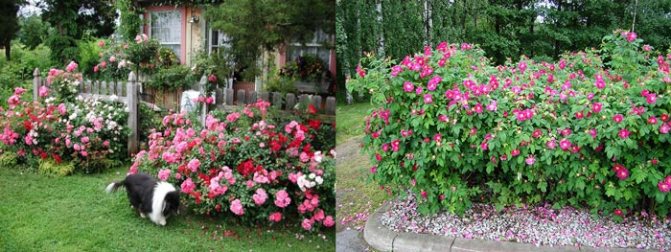

Its leaves are wrinkled, of a bright green color with a ribbed edge with denticles, with a gray-green shade of pubescence below, growing up to 22 centimeters.
Her flowers are located singly or are collected in inflorescences up to 8 pieces, with a color ranging from white and delicate pink to deep red. Flowers can be either double or simple, and reach a diameter of 6 to 12 centimeters.
The first wave of flowering shrub begins in May, or early June.
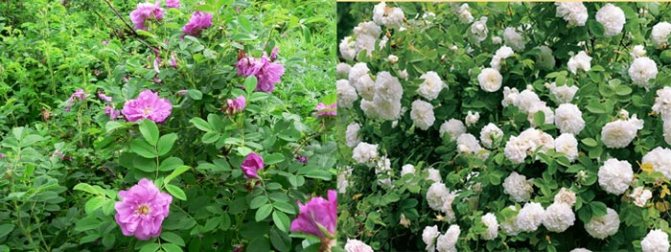

After it, on the bushes, there is a simultaneous formation of orange fruits in summer, burgundy or lemon in autumn, and new inflorescences for the next wave.
The roots of the wild rose are powerful, penetrating up to 2.5 meters into the depth of the soil, and spreading several meters to the side, with numerous shoots. This feature serves well for protection from small animals and for strengthening the soil on hillsides and in ravines.
The fleshy fruit is large, up to 3 centimeters long.During the season, up to 3.5 kilograms of harvest can be obtained from one bush, which is used both for medicinal purposes and for preparing drinks and desserts.
Wrinkled rose varieties
Currently, the most common varieties of roses are considered those in the name of which the surname Grothendorst is present.
It was this talented and famous Dutch rose gardener who bred and founded most of the varieties, which continues his endeavors to this day.
Rose care
The wrinkled rose does not require complex maintenance, it is not sensitive to sudden changes in temperature and drought. But to get a beautiful flowering, it is better to observe some conditions.
Treat and remove all root processes located away from the shrub. It is better to cut all remaining shoots to a height of 18 centimeters from the ground, and leave about 5 branches that are well developed. When these shoots reach a height of 70 centimeters, their tops must be pinched, stimulating fruiting.
Further, the crown is pruned annually and those branches that do not bear fruit or are damaged are removed. The number of branches in a shrub should be about 16-20, for young shrubs, and then every year 2-3 shoots should be replaced with new ones.
Reproduction
There are three ways to reproduce a wrinkled rose:
Diseases and pests
Rosehip rugose is resistant to various diseases and almost all pests. But if you do not follow the rules of care, then the plant may weaken.
And in this case, the rose can be susceptible to diseases such as powdery mildew, various fungi, rust and rot.
It will also become prey for such pests as spider mites, leaf rollers and sawflies. For treatment and from parasites, insecticide treatment can be carried out, in the spring until the kidneys swell.
Recipes
Rosehip tincture.
We take a tablespoon of dry wild rose fruits, grind them in an electric coffee grinder, put them in an enamel bowl, fill them with two glasses of boiling water. Cover with a lid and put in a water bath for fifteen minutes. Then we insist for another half an hour. We filter the tincture. This infusion is taken in half a glass twice a day, before meals. For children, you can add a teaspoon of honey to a portion of the tincture.
This infusion is effective for atherosclerosis, hypertension, infectious diseases, anemia, bleeding of various nature and nature, to improve vision.
Rosehip flower broth.
We take one hundred grams of dry raw materials (rosehip flowers), pour a glass of water, boil over low heat for an hour. We filter. This broth is used as a lotion for the eyes, with erysipelas.
Rosehip flower juice.
Fresh rosehip flowers are collected, passed through a meat grinder, juice is squeezed out of the resulting mass. It is sprinkled with sugar, and taken in a tablespoon half an hour before meals.
Rosehip root broth.
We take a tablespoon of dry rosehip roots, pour a glass of boiling water, cook over low heat for fifteen minutes (no more). We then insist for another fifteen minutes, filter. The broth should be taken warm (it is better to brew in a thermos), one quarter of a glass four times a day. This broth is recommended for hypertension, renal inflammation, kidney stones.
The same decoction of rosehip flowers is recommended for dysentery and bowel disorders.
A decoction of young shoots of rose hips, made according to the above recipe, is taken for radiculitis, and is used for taking medicinal baths for paralysis.
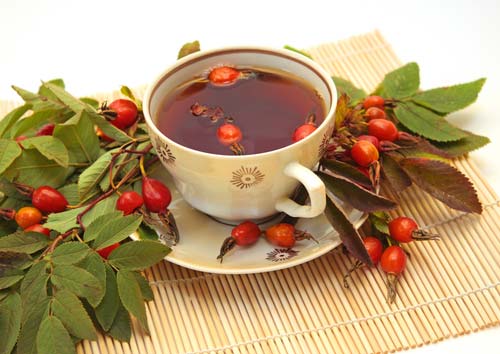

Rosehip liqueur.
We take a glass of dry rose hips, mix with a glass of sugar, three glasses of vodka. We leave it all in the sun for five days. Then add two more glasses of vodka, insist for another five days. Then we filter the liquor, squeeze out the raw materials. It should be taken as a medicine, fifteen grams a day, before meals, in the morning.
Habitat
Cinnamon rosehip is widespread in most of the CIS. It can be found in the European part - with the exception of the Baltic countries and the Black Sea region of Russia, in Western Siberia - with the exception of the Far North, in Eastern Siberia - in the Angara-Sayan region, in the Yenisei region, the plant is rarely found, as well as in Central Asia.
Rosehip grows in sparse mixed and deciduous forests, among shrubs, along forest edges, glades, in meadows, along ravines and mountain gorges, on rocky slopes, prefers the banks of rivers, lakes and other bodies of water. There are both single plants and groups (thickets).
Healing properties
Ointments, tea drinks, tinctures based on blackthorn raw materials are intended for internal and external use. Craftsmen masterly heal abrasions, cracks in the skin and nipples of nursing women with them at home. Traditional pharmacological agents help to get rid of chronic and acute problems with the genitourinary, circulatory, and digestive systems: they strengthen the walls of blood vessels, inhibit pulmonary and uterine bleeding, stimulate the production of hormones and bile. Also thanks to them you can win:
- colds, arthritis, flu, any throat ailments;
- ulcers, frostbite, dermatitis;
- burns, eczema, obesity;
- a number of eye diseases, hepatitis, cholecystitis;
- atherosclerosis, cholangitis, diathesis.
According to research, symptoms in children, adult men and women are relieved easily. Complications can be safely avoided or mitigated. Recovery comes faster, even if a person simply drinks herbal tea with berries and honey.
Thorny (thorny) rose
Considering a topic such as rose hips, the species and varieties of this plant, you certainly need to remember the thigh-leaved (thorny) rose. It is a very well-known and common variety. Outwardly, it is a sprawling shrub with small beautiful leaves and pale yellow or white flowers that have a very strong aroma. Such plants bloom very abundantly, but not for long, as a rule, no more than three weeks. But their fruits have an unusual black color.
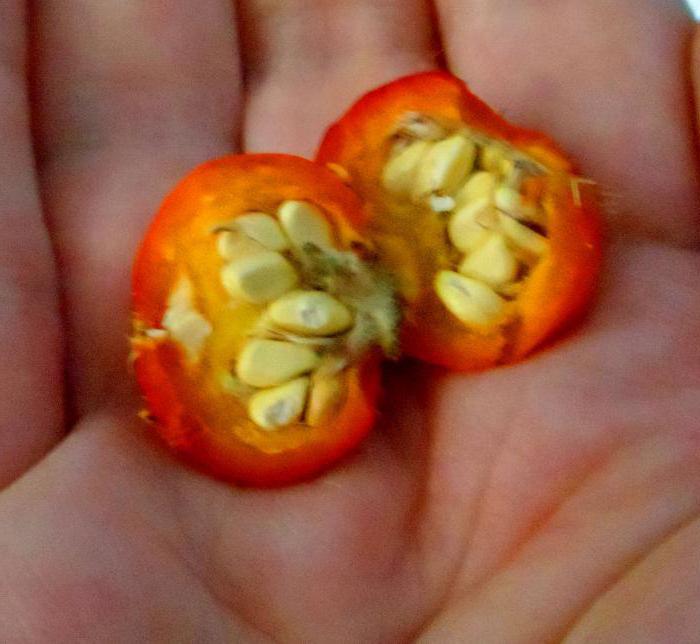

This variety of wild roses is very variable, the height of the bushes can vary from one to two meters. The color of flowers can also be either lemon or pink. This particular variety of roses is very popular in Scotland and England. It was in these parts that several hundred different varieties were bred. Among them there are terry, variegated, two-colored species.
This hybrid group is known all over the world under the name Scottish Roses. In our latitudes, the most common terry species is about two meters high. It has one interesting feature: if you once planted this type of rosehip, then in the future you will hardly be able to get rid of it. Bushes throw underground growth over considerable distances. And a small piece of root that remains in the ground continues to germinate further. Therefore, it is very difficult to uproot such a rose, and it is also impossible to keep it from spreading throughout the entire site. For this reason, the thigh-leaved variety is planted in places where you can not worry about its "sabotage". Moreover, this variety of wild rose has its own advantages: frost resistance, drought resistance, the possibility of excellent strengthening of the slopes.
My Hammerberg
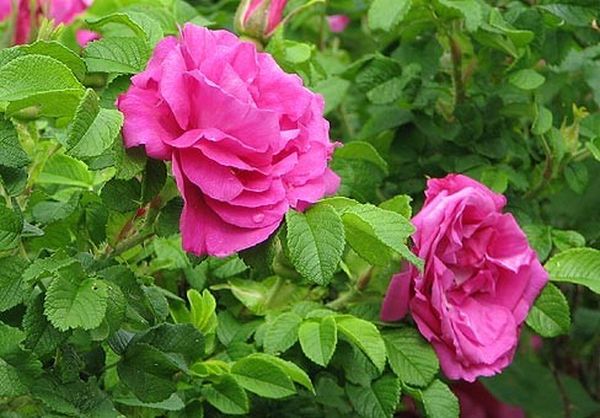

The rose is wrinkled with interesting violet-red red weak double flowers with yellow stamens. Cupped shape, diameter up to 9 cm; up to 17 petals in one flower. Brushes are composed of approximately 5 colors. The aroma is well expressed. Flowering is long and plentiful, lasts from June to September. Due to its high frost resistance, the variety can winter without additional shelter. In general, it belongs to light-loving varieties, but it also tolerates partial shade.
Biological description
A multi-stemmed, deciduous (rarely evergreen) shrub.Belongs to the morphological order of Rosaceae, represented by about 400 species. For Russia, 50-100 are typical, the rest are scattered over the northern hemisphere up to the tropical belt. Cultural varieties - these include false rosehips, purely decorative - there are tens of thousands.
The appearance is determined by the environmental conditions. Typical sizes are 2-3 m in height, but there are specimens of 25 cm or 10 m, creeping or climbing. Rounded leaves can be smooth or pubescent. The branches have thorns - short and soft or long, sharp. Often there are growths-nuts of a strange structure, they are called galls.
Unpretentious. Wild plants are found both in the humid stuffiness of the jungle and on waterless rocks. They are not afraid of frost, drought, although they are not found in deserts. Suitable for cultivation in the garden, with propagation from seedlings, annual shoots. The lifespan is several tens, less often hundreds of years.
They give small round, oval or pitcher-shaped fruits, similar to mini-fruits of rich red, orange, black or brown shades (in the middle lane this happens by August-September). Single-seeded, do not germinate immediately after entering the soil, but only after 2-3 years. The botanical formula of rosehip flowers, describing the structure, is 5 sepals, 5 petals, many pistils and stamens. They bloom in May-June, at dawn, and close at night.
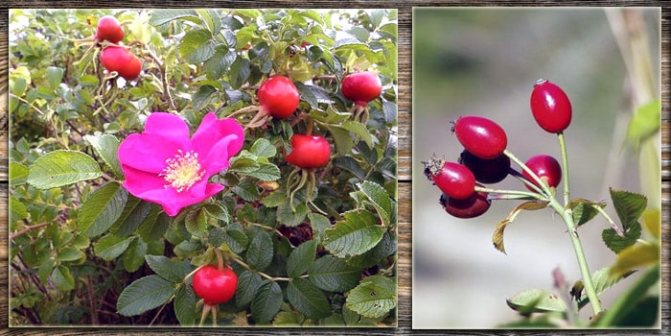

Berries in nature serve as food for field and forest birds, a number of animals: foxes, mice, hares. Shoots and twigs are eaten only by goats, sheep and camels that can chew thorns. The chemical composition of raw materials is heterogeneous, depending on the region, but almost everywhere it is traditionally considered an excellent source of vitamins.
Rosehip on a personal plot: photo
Hypotension remedy
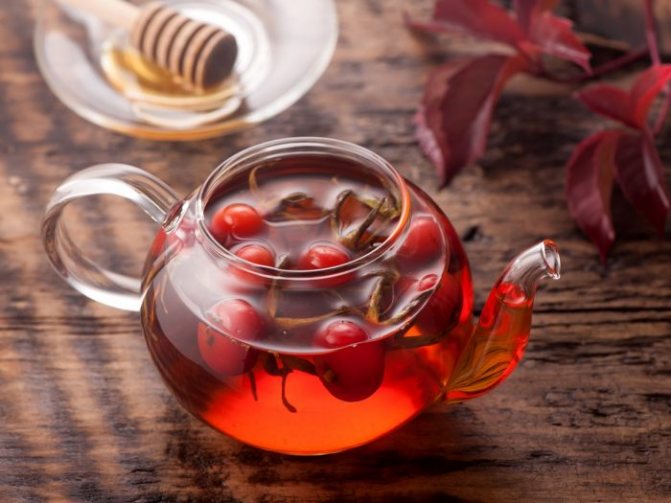

In case of sharp drops in blood pressure, it is recommended to use an infusion of dried fruits of the needle rose hips. About 100 grams of raw materials are crushed and poured with strong alcohol in a volume of 0.5 liters. The container is covered with a lid and sent to a dark place for a week. The product is shaken periodically. The finished composition is filtered qualitatively. The resulting liquid is consumed in 20-35 drops 3 times a day before meals.
Leaf shape
The appearance of the green frame depends on the type of plant. Therefore, the description of the rosehip leaf may vary. Leaves can be rounded or elliptical in shape. Their base may look heart-shaped or round. At the edges, the leaves can be serrate, double-serrate or serrate-crenate. They are also naked or with glands.
Rosehip leaves also differ in color. They can be green, reddish, or bluish. But that's not all of their differences. Also, depending on the type, they can be leathery, webbed, tough; wrinkled or smooth; naked or edged.
When looking for an answer to the question of which leaves a rose hip has, it is also important to remember that their size, thickness and shape directly depend not only on the species, but also on the conditions in which it grows. The influence is exerted by illumination, temperature, air humidity and the content of carbon dioxide in it, the supply of plants with water.
How is rose wrinkled used
The plant is used not only for decorative purposes. It is also grown for flowers and fruits. The petals can be used to make aromatic tea and jam, as well as refreshing eau de toilette for the face.
Compotes are cooked from berries, decoctions and infusions are prepared for the treatment of certain diseases. Like rose hips, rugose contains ascorbic acid, albeit in smaller amounts. Therefore, the fruits are used for the treatment and prevention of vitamin deficiencies, used in dietary therapeutic nutrition.
Any of the varieties of wrinkled roses is worth it to decorate a garden or flower bed near the house. However, you should be careful with people prone to allergic reactions to odors and pollen.
The cost of seedlings depends on the type of plant and the region. For example, in the Moscow region, the price fluctuates around 500-700 rubles apiece. In the southern regions (Rostov Region, Krasnodar Territory), the cost is lower - about 300 rubles.
Growing rose hips from seeds
Rosehips can be propagated in three ways: by seeds, cuttings (seedlings) and root suckers.
Seeds are harvested from unripe fruits at the end of August in order to sow them in the ground in the fall (in October). The option of sowing in the spring is possible, but then 2-3 weeks before the estimated date of planting in open ground, it is necessary to grow seedlings in separate containers.
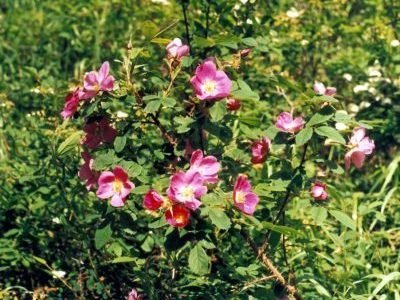

Chemical composition
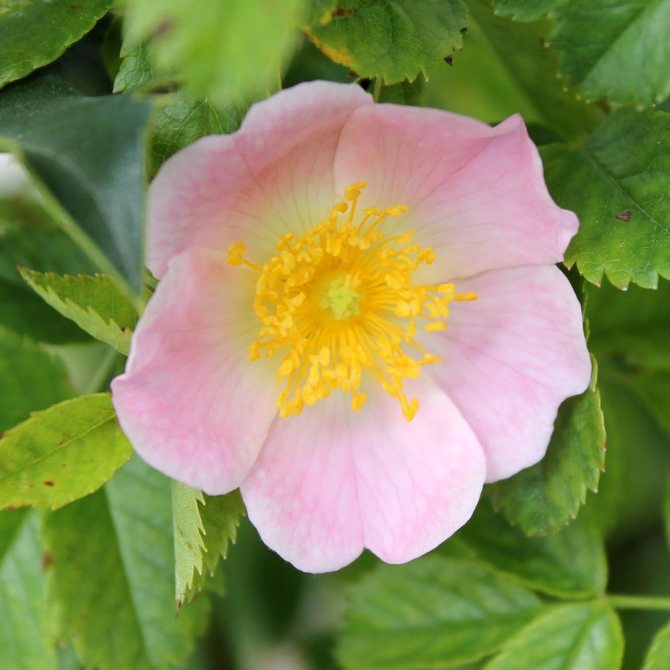

Rose hips are rich in sugars. The structure of the plant contains many organic acids useful for the human body. If we talk about vitamin C, there are several tens of times more useful nutrient here than in citrus fruits. Also, the plant acts as a source of vitamins of groups B, K, E and P. Several berries of the needle rose can satisfy the body's daily need for vitamins.
Among other useful substances, it is worth noting the abundance of carotene, flavonoids, iron, calcium, phosphorus, and magnesium salts. The structure of the plant contains tannins, essential oils, pectins.
Gardeners reviews
Lyubashka
At our dacha there is a small (in terms of length) hedge made of wild rose hips. Nobody planted him on purpose, he was already growing there when the plots were allocated for summer cottages. Left. We cut regularly.
Guest_Murlik_
Our neighbors at the dacha grows along the fence. So beautiful. They cut it periodically. What they have on the site is not visible.
"Ray"
The bush is high (up to 3 m tall), erect. There are few thorns on green branches. Basically, the thorns are located at the base of the bush. It blooms in a pale pink color. Red oval berries are large, weighing up to 5 g. Properties: frost resistance, disease resistance, pest damage. The ripening process begins in August.
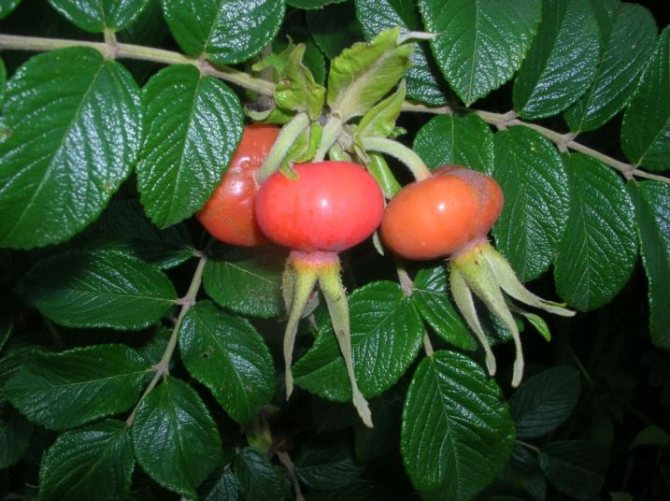

Application
Doctors prescribe the use of medicinal rosehip broths and oils, without specifying which raw materials should be used. Both fresh and dry are beneficial if properly harvested and stored. When there are no berries or leaves with perianths available, it is not forbidden to take squeezed rose oil (because of a familiar word, confusion often arises, but we are talking about blackthorn), stems, rhizomes. They can be assembled by yourself or purchased from a good manufacturer.
Industry
Vitamin factories on different continents have long been processing wild rose in huge volumes. In Russia and the USSR, on the territory of Lithuania, Bashkiria, the Chelyabinsk region, the Moscow region, plantations with perennial clumps were created, where the most nutrient-rich, large-fruited shrub varieties were grown. Canning factories produced rose preserves. Confectionery, perfumery, wine, pharmaceutical - oil, for 1 kg of which 3 thousand kg of fresh petals are spent, collected in the morning, exclusively by hand. The oil from the seeds is used for the production of drying oil.
Medicine
Berries are mainly used because of the greatest amount of antioxidants, trace elements and other active components in the cells. Ready-made forms - dragees, tablets, extracts, whole dried fruits are often sold. Fresh (seasonal, autumn product), calorie content of 162/100 g, homeopaths like to use because of the suitable characteristics. Typical indications for treatment:
- anemia, exhaustion, diarrhea;
- disorders of carbohydrate metabolism;
- inflammation of the kidneys, liver, intestines;
- typhoid, tuberculosis, scarlet fever (make vapors, tinctures).
Popular drugs - "Galascorbin", "Holosas", anti-asthma medicines. According to the pharmacopoeia, syrup is considered a prophylactic agent.
Learn more: Common hawthorn species: description, application
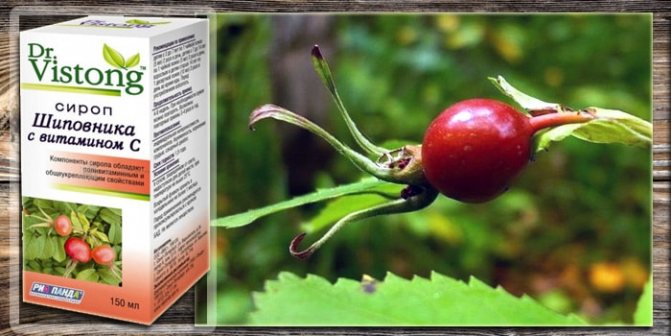

Cosmetics
Shops and pharmacies offer nourishing creams based on carotene (oil extract), which help to improve complexion, smooth wrinkles, reduce excessive sensitivity, and normalize water metabolism. It is recommended to independently prepare infusions and decoctions for washing, which are suitable for all skin types, including acne, adolescent. They cleanse well, refresh, tone up, effectively relieve inflammation, peeling, wounds, and also protect against UV radiation. The most powerful anti-aging effect is obtained from the oil obtained after cold pressing of raw materials.
Fragrant wax, the juice from the petals is used for the production of super-valuable soaps, lipsticks, perfumes. It is included in the composition of 98% of perfumes for women and 46% for men, it is also added to honey with milk, baths are made, achieving smoothness and tenderness of the skin. They take care of their hands, lubricating them with a mixture of rose water, ammonia and glycerin.
Cooking
Most of the common representatives of the genus Rosa (literal name from Latin) produce fruits that can be eaten fresh, dried or after heat treatment. Rosehip petals are used raw, cinnamon ones are used for jam, wrinkled ones - for jelly, liqueurs. Tea surrogates give infusions of flowers, less often of many types of leaves. Similarly processed blackthorn nuts serve as a substitute for coffee. Young shoots and leaves are used as ingredients for some snacks and salads. Thanks to the raw materials of blackthorn, the wines become spicy, it is suitable for the preparation of soft drinks.
Diseases and pests
| Powdery mildew, gray rot Control measures:
|
| Spider mite Control measures:
|
Propagation of rose hips by root suckers
For reproduction by root suckers, it is necessary to choose only the most productive bush, from which in late autumn (or early spring) the most reliable baby is isolated, which can develop independently.
Hilling is carried out several times, and after the baby has put down its own roots, then it can be safely separated from the mother bush.
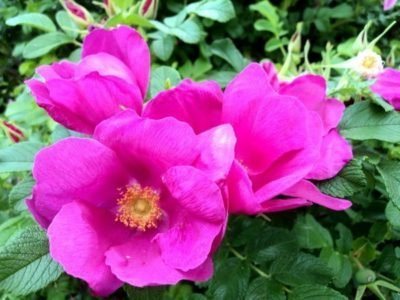

How to spray from rosehip fruit diseases
The causative agent of the disease of rose hips, in which spots appear on the berries, is the mushroom Phyllosticta rosae Desm. Fruit spots are round, scattered, dark brown with a wide purple-brown border. Over time, the center of the necrotic tissue turns ash gray, but a wide purple border always remains. Another fungus, Phyllosticta rosarum Pass., Is also common, causing the formation of grayish-white spots with a wide crimson border. In the center of necrotic spots, small dotted black fruiting bodies of the wintering stage of fungi are formed. Affected leaves turn yellow and fall off prematurely. The infection persists in the fallen diseased leaves.
Control measures. Same as against black spot. Remove all affected parts of the shrub before spraying disease-fighting rosehips.
Contraindications
Funds based on needle rose are not recommended for people who have a tendency to develop thrombophlebitis. Since the substances in the plant have an astringent effect, the likelihood of blockage of blood vessels increases.
Caution should be exercised when using rosehip infusions for people suffering from hypertension. The list of contraindications also includes ulcerative diseases of the digestive system, stroke.
After consuming concentrated decoctions of the plant, it is advisable to resort to rinsing the mouth. Such products contain an abundance of organic acids that can corrode tooth enamel.
Decoction against stomach cramps and indigestion
Thoroughly chopped bush branches in the amount of 3 tablespoons are poured into 0.5 liters of water. The composition is placed on moderate heat and brought to a boil. The flame is reduced to a minimum by continuing to boil the product for 10 minutes. The container is removed from the stove and covered with a lid. The vessel is insulated, after which the agent is infused for an hour. The broth is brought to its original volume using boiled water. If there are problems with the work of the digestive organs or there is pronounced discomfort in the stomach area, the medicine is taken several tablespoons before each meal.


